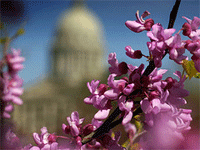OK did ya know? State Tree
The Redbud was officially made the Oklahoma state tree in March 30, 1937.
Under Title 2 (Agriculture) of the Oklahoma Statutes is:

About the Oklahoma Redbud
The Oklahoma Redbud tree, Cercis reniformis, 'Oklahoma', has glossy green foliage. This redbud tree was discovered growing wild in the Arbuckle Mountains of Oklahoma in 1964. The Oklahoma redbud is a small, deciduous understory tree which typically grows to 12-18' tall. This tree has clusters of tiny, wine-red, pea-like flowers that bloom profusely on the branches and mature trunks for 2-3 weeks in early spring (March-April) before the foliage emerges. The Oklahoma redbud's heart-shaped leaves open soft pink but gradually mature to a glossy rich green. Pendulous, flat, bean-like, 2-4" long seed pods resembling snow peas appear after flowering.
Oklahoma redbud trees have fall color that is variable, but often includes attractive shades of reddish-purple and orange. Redbuds are true harbingers of spring. It is easily grown in average, medium wet, well-drained soil in full sun to part shade. Part shade is best in hot climates. Not reliably winter hardy throughout USDA Zone 5 where it should be planted in a protected location. Excellent small tree for lawns, woodland gardens or naturalized areas. Effective planted as a specimen or in groups. Street tree in residential areas. *
How It Became The Oklahoma State Tree
In the 1930s, Mrs. Mamie Lee Browne helped organize a campaign for adopting the "eastern" redbud as Oklahoma's state flower. Later this was changed to a campaign for a state tree, when they learned Oklahoma already had a state flower, the mistletoe.
In March 1937, Governor E. W. Marland was about to sign the bill making the redbud the state tree, when a telegram arrived starting a controversy over the redbud. Mrs. Edward Campbell Lawson of Tulsa, president of the National Federation of Women's Clubs, sent the telegram claiming the redbud was the Judas Tree that Judas Iscariot used to hang himself after he betrayed Christ.
The controversy appeared in Newspaper stories and editorials all over the United States and other countries.
The dispute was resolved by an Oklahoma City resident who was a native of Jerusalem. He affirmed that there was no connection between Oklahoma's Redbud tree and Israel's "Judas tree."
With the controversy resolved, on March 30, 1937, Governor Marland signed the bill into law, making the redbud Oklahoma's state tree.
More Information & Other References:
Under Title 2 (Agriculture) of the Oklahoma Statutes is:
- §16-69 - State Tree - Redbud
The redbud tree shall be adopted and the same be made the official tree of this state.

| Oklahoma Redbud Facts: | |
| Scientific Name: | Cercis reniformis |
| Mature Height: | 20-30 feet |
| Mature Spread: | 15-20 feet |
| Mature Form: | Dense, rounded |
| Growth Rate: | Moderate |
| Leaf Type: | Deciduous |
| Wood Strength: | Soft wood |
| Sun Exposure: | Full Sun - Partial Sun |
| Soil Moisture: | Moist |
| Soil Type: | Widely adaptable |
| Flower Color: | Pink |
| Foliage Color: | Green |
| Fall Color: | Yellow green |
| Zones: | 6 - 9 |
| Common Pests: | Canker, leaf spots, verticillium wilt, tree hoppers, caterpillars, scales, leaf hoppers and root rot. |
The Oklahoma Redbud tree, Cercis reniformis, 'Oklahoma', has glossy green foliage. This redbud tree was discovered growing wild in the Arbuckle Mountains of Oklahoma in 1964. The Oklahoma redbud is a small, deciduous understory tree which typically grows to 12-18' tall. This tree has clusters of tiny, wine-red, pea-like flowers that bloom profusely on the branches and mature trunks for 2-3 weeks in early spring (March-April) before the foliage emerges. The Oklahoma redbud's heart-shaped leaves open soft pink but gradually mature to a glossy rich green. Pendulous, flat, bean-like, 2-4" long seed pods resembling snow peas appear after flowering.
Oklahoma redbud trees have fall color that is variable, but often includes attractive shades of reddish-purple and orange. Redbuds are true harbingers of spring. It is easily grown in average, medium wet, well-drained soil in full sun to part shade. Part shade is best in hot climates. Not reliably winter hardy throughout USDA Zone 5 where it should be planted in a protected location. Excellent small tree for lawns, woodland gardens or naturalized areas. Effective planted as a specimen or in groups. Street tree in residential areas. *
How It Became The Oklahoma State Tree
In the 1930s, Mrs. Mamie Lee Browne helped organize a campaign for adopting the "eastern" redbud as Oklahoma's state flower. Later this was changed to a campaign for a state tree, when they learned Oklahoma already had a state flower, the mistletoe.
In March 1937, Governor E. W. Marland was about to sign the bill making the redbud the state tree, when a telegram arrived starting a controversy over the redbud. Mrs. Edward Campbell Lawson of Tulsa, president of the National Federation of Women's Clubs, sent the telegram claiming the redbud was the Judas Tree that Judas Iscariot used to hang himself after he betrayed Christ.
The controversy appeared in Newspaper stories and editorials all over the United States and other countries.
The dispute was resolved by an Oklahoma City resident who was a native of Jerusalem. He affirmed that there was no connection between Oklahoma's Redbud tree and Israel's "Judas tree."
With the controversy resolved, on March 30, 1937, Governor Marland signed the bill into law, making the redbud Oklahoma's state tree.
More Information & Other References:
